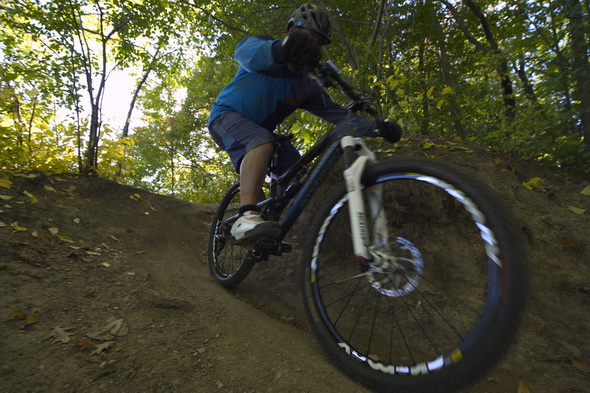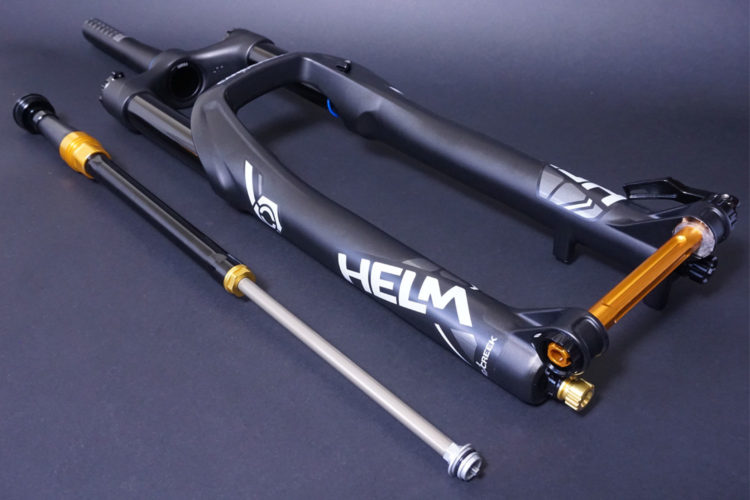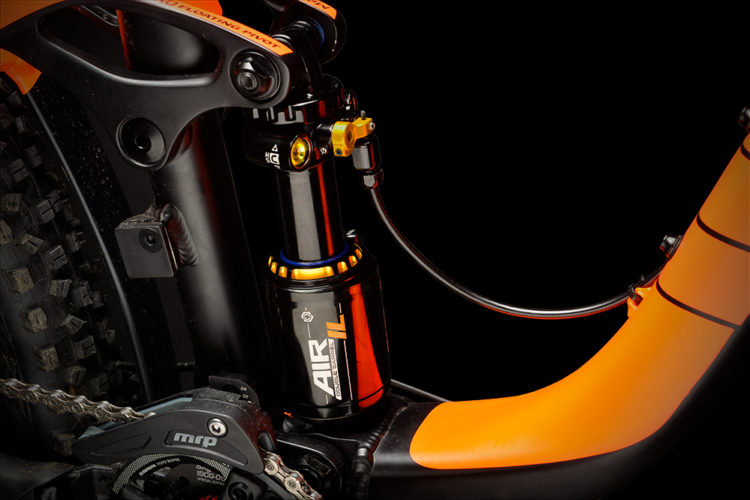Full disclosure: Cane Creek is one of my favorite rear shock brands. They continue to better themselves every time they release a new product. The new Cane Creek Double Barrel Air XV CS is another shining example of progressive engineering.
Specs
With significant changes to the control layout and addition of a climb switch, Cane Creek has taken a shock that was already more than capable and improved it significantly. Unlike the traditional way of adding a platform to a damper’s low speed compression side, Cane Creek controls both low speed compression and rebound. This design dramatically reduces energy-sapping pedal bob. The patent-pending climb switch essentially turns on a set of internal climbing circuits that bypass the regular low speed compression (LSC) and low speed rebound (LSR) circuits. These new circuits allow for a more tuned compression and rebound curve that helps keep the tire following the terrain, while reducing bob.
For a demonstration of the difference between CS on and off using real data, check out this video:
Right about now you might be thinking it’s just a bunch of PR jibber jabber. Well, once you try one for yourself (as I did), you will think otherwise. If you think about it, once the CS switch is activated, in all reality you’re using another two extra circuits for LSC and LSR, making that really 4 low speed circuits and two high speed circuits.
Not only did the DBair get the new climb switch, but it received a new set of dials as well. The previous versions had LSC / HSC and LSR / HSR bundled together, which required Cane Creek’s own special wrench to adjust it. You can now use a hex key to adjust each individual dial, as they have now been separated.
As the name implies, the XV is the new extra volume can, which when installed (you can order these separately if you have an existing unit without one) gives the rider a plusher ride characteristic with less of a ramp up in spring rate.
Internally the Cane Creek DBair retains its proven Twin Tube technology, which is perfect for small bump sensitivity and compliance. Essentially, Cane Creek’s approach forces all the fluid through the adjuster circuits (with no bypass needles on the main piston whatsoever), forever circulating fluid between the tubes of the damper. This forces the fluid either below or above the piston or above, depending on the compression side or rebound side of the stroke.
As for the air can, the design allows for only one inflation port. The negative spring side is taken care of automatically. In addition, one underutilized feature that I personally like is the adjustable volume: it really helped me get the exact air spring curve for my riding style!
Installation and Tuning
Changing out a rear shock on most bikes is dead easy, as there are usually only two bolts that are torqued to a specific level that need to be removed and re-torqued. Setting my torque wrench to 9Nm was all I needed to get things going. My personal Cane Creek DBair XV CS came with the correct adapters (sold separately). If you’re not sure what size you need, contact your bike’s manufacturer for correct sizing, then contact your LBS and have them order a set for you.
Tuning the DBair is another story altogether. Depending on where you get your DBair, you will have one of two tunes: when ordered as a generic part online or from an LBS, you’ll get a factory setting. If the DBair was ordered from Cane Creek, or if you’re lucky enough to get one on your new bike, there may be a tuning card that has a specific tune already applied to it. Either way, that’s a baseline starting guide. Check out Cane Creek’s website for other base tunes.
With every DBair XV CS comes a field tuning guide, owners manual, a pen, and an allen key to tune this monster. I highly recommend going over all that information before you go out and start tuning… there’s such a thing as a bad shock tune.
The initial settings on my DBair CS were:
HSC 1
LSC 13
HSR 2
LSR 15
I set the sag on this unit to 22mm. Out for testing, I found that it was a bit too slow on the compression side of things, making it a bit edgy and harsh. I also found that I had a slight bucking feeling in the back. Eventually I ended up with:
HSC 0.75
LSC 8
HSR 2.25
LSR 14
Sag 22mm
Spacers 1 small
These settings allowed for easier compression, taking the edge off the bumps when I hit them, and slowed down the rebound just enough to prevent bucking from the rear. I also decided to add one spacer in the XV air chamber. This allowed for the 22mm sag, and when I really got into the travel, the spring rate rose higher, giving the shock a more bottomless feel.
Out on the Trail
Out on the trail, the Cane Creek DBair truly dominates! The added XV can adds to the tuneability and initial plushness of the suspension, while the CS switch dramatically improves climbing efforts.
The only real negative feedback I have is that the climb switch lever can be a bit tough to access on my frameset, and clearance is a bit on the tight side. On occasion, I found I was fumbling for the switch: a remote would be a great option.
Aside from the lack of a remote, the DBair XV CS worked great at controlling the rear wheel in every challenging situation I threw at it. I found that the wheel tracked so closely to the ground that it gave very little up. The great tracking ability allowed me to freely choose what line I wanted to follow, up or down.
As I mentioned above, you do need to play around a bit with the tuning until you have things set right–as, unlike some other brands, the tuning band for each circuit is quite wide. The wrong settings, either too much or to little, will negatively affect performance. So keep at it. I found the field tuning guide very helpful, along with the supplied mini pen, which I used to take notes on what I found to be good and bad. Then, when possible, I ran the same trail again with the new changes, further noting improvements (or losses) in performance.
Bottom Line
With performance this good, I can honestly say that I think the DBair is well-worth the $695 US sticker price. I might be sticking my neck out a bit on this one, but I guarantee that this shock will improve your ride and enjoyment of the trails.
A big thanks to the folks at Cane Creek for sending down the DBair XV CS for review.





























